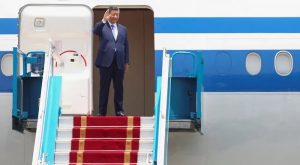China’s central bank cut key policy rates on Tuesday – for the second time in three months – after further data showed the economy weakening on a broad range of fronts.
The People’s Bank of China moved unexpectedly just before the release of information from July that showed retail sales, industrial output and investment all rose more slowly than anticipated.
The latest National Bureau of Statistics (NBS) data followed a raft of weak indicators last week that highlights intensifying pressure on the economy.
However, analysts say more support is urgently needed to revitalise growth, as the rapid loss of the post-Covid economic rebound has shaken global financial markets, leaving the world’s second-biggest economy were severely underpowered.
ALSO SEE: China Offers Foreign Investors Safeguards to Lure in Funds
The PBOC said it lowered the rate on 401 billion yuan ($55.25 billion) worth of one-year medium-term lending facility (MLF) loans to some financial institutions by 15 basis points to 2.50% from 2.65% previously.
The cash injection was to counteract factors including tax payments in order to “keep banking system liquidity reasonably ample”, the PBOC said in an online statement.
The central bank also injected 204 billion yuan through seven-day reverse repos while cutting borrowing costs by 10 basis points to 1.80% from 1.90% previously, it said.
Nomura sees ‘imminent downward spiral’
“All the main activity indicators undershot consensus expectations in July, with most either stagnant or barely expanding in month on month terms,” Julian Evans-Pritchard, economist at Capital Economics, said.
“And with financial troubles at developers such as Country Garden likely to weigh on the housing market in the near-term, there is a real risk of the economy slipping into a recession unless policy support is ramped up soon.”
Nomura analysts were equally downbeat on China’s economic outlook.
“We believe the Chinese economy is faced with an imminent downward spiral with the worst yet to come, and the rate cut this morning will be of limited help,” they said.
Industrial output grew 3.7% from a year earlier, slowing from the 4.4% pace seen in June, the NBS data showed, and was below expectations for a 4.4% increase in a Reuters poll of analysts.
Retail sales, a gauge of consumption, rose 2.5%, down from a 3.1% increase in June and missed analysts’ forecasts of 4.5% growth despite the summer travel season.
It was the slowest growth since December 2022, and shows just how much of a challenge authorities face as they try to make consumption the key driver of future economic growth.
State banks sell dollars as stem yuan fall
Asian stocks stalled at one-month lows, the yuan hit a 9-month nadir, while the dollar held broadly firm after the weak Chinese data and latest policy easing measures.
Following the rate cuts, China’s major state-owned banks were seen selling US dollars and buying yuan in a bid to stem rapid declines in the currency, three people with direct knowledge of the matter said.
Sovereign bond yields fell to three-year lows, and benchmark stock indexes were down.
Record-low credit growth and rising deflation risks in July necessitated more monetary easing measures to arrest the slowdown, market watchers said, while default risks at some housing developers and missed payments by a private wealth manager also soured market confidence.
Urgent issue of special bonds and RRR cut tipped
Nie Wen, an economist at Hwabao Trust, expects special bonds to be introduced urgently and said the probability of a reserve requirement ratio (RRR) cut in the short run is relatively large.
Policymakers last month released a batch of stimulus measures, from boosting auto and home appliances consumption, relaxing some property restrictions to pledging support to the private sector, as a post-Covid rebound rapidly lost steam since the second quarter.
The catering sector, which reaped benefits from the Covid reopening, saw slower revenue growth in July from June. Investment in the private sector shrank 0.5% in the first seven months, extending 0.2% decline in the first half of 2023.
‘A painful transition’
The persistent drag of the property sector, mounting local government debt pressure, high youth jobless rate and cooling foreign demand continue to be major impediments to fostering a sustainable economic revival.
China is undergoing a painful transition to a less debt-fuelled, less property-centric and more consumer-driven economy, Robert Carnell, Asia-Pacific head of research at ING, said.
“We will continue to see weak macro data for the foreseeable future. It is a necessary part of the adjustment and is far preferable to resurrecting the debt-fuelled property model that propelled growth previously. But we do need to lower our expectations for China’s growth.”
Other data on Tuesday showed fixed asset investment expanded 3.4% in the first seven months of 2023 from the same period a year earlier, versus expectations for a 3.8% rise. It grew 3.8% in the January-June period.
Investment in the property sector tumbled 8.5% year-on-year in January-July, after shrinking 7.9% in January-June, extending its fall for the 17th consecutive month.
Jobless rate climbs, youth data to be suspended
The nationwide survey-based jobless rate climbed slightly to 5.3% from 5.2% in June.
After the youth jobless rate rose to record high of 21.3% in June, the NBS suspended the publication of youth jobless rate from August.
China set its 2023 growth target at around 5%, but Nomura analysts warn the country could miss the goal again as it did last year.
“We also see bigger downside risk to our 4.9% year-on-year growth forecast for both Q3 and Q4, and it is increasingly possible that annual GDP growth this year will miss the 5.0% mark.”
Pressure on the yuan
Ken Cheung, chief Asian FX strategist at Mizuho Bank, said: “The surprising rate cut was a prompt response to support subdued credit data and China recovery (that) may unleash yuan depreciation pressure towards 7.3.
“In particularly, the PBOC may intend to support the medium-term credit conditions via the asymmetric cut, and opened the way for a cut to LPR, especially the 5-year LPR, to support the struggling property sector.”
The MLF rate serves as a guide to the LPR and markets mostly use the medium-term policy rate as a precursor to any changes to the lending benchmarks. The monthly fixing of the LPR is due next Monday.
China remains an outlier among global central banks as it has loosened monetary policy to shore up a stalling recovery whereas others have been in tightening cycles as they battle high inflation.
Tuesday’s rate move has widened the yield gap with other major economies, particularly the United States, putting more pressure on the yuan and risking outflows.
China’s yuan has lost about 5% against the dollar so far this year to become one of the worst performing Asian currencies. The yuan traded at 7.2842 per dollar as of 0145 GMT, compared with the previous close of 7.2580.
Yields on China’s 10-year government bonds eased to 2.56%, the lowest level since May 2020.
- Reuters with additional editing by Jim Pollard
ALSO SEE:
Weak Demand Pushes China Into Possible Year-Long Deflation
China Property Crisis Intensifies, Cloud Over Country Garden
China Deflation Risks Deepen as Sharp Pay Cuts Hit Consumption
Multiple Moves Needed to Defuse China’s Local Debt Crises
























